Plasma-induced graft polymerization on the surface of aramid fabrics with improved omniphobicity and washing durability
2020-06-14EshragaSIDDIG尚晓冉YuXU徐雨TaoHE何涛MingGAO高明BaojingYANG杨宝敬TianshuWANG王天舒andJingZHANG张菁
Eshraga A A SIDDIG (尚晓冉),Yu XU (徐雨),Tao HE (何涛),Ming GAO (高明),Baojing YANG (杨宝敬),Tianshu WANG (王天舒) and Jing ZHANG (张菁),3,6
1 New Energy Material and Device,College of Science,Donghua University,Shanghai 201620,People’s Republic of China
2 College of Engineering,Sudan University of Science and Technology (SUST),Khartoum 11111,Sudan
3 Magnetic Confinement Fusion Research Center,Ministry of Education,Shanghai 201620,People’s Republic of China
4 Shenzhen Institutes of Advanced Technology,Chinese Academy of Sciences,Shenzhen 518055,People’s Republic of China
5 Precision Chemical Technology (Shanghai) CO.,Ltd,Shanghai 201613,People’s Republic of China
6 Authors to whom any correspondence should be addressed.
Abstract
Keywords:aramid fabrics,plasma-induced graft polymerization,hydrocarbon resistance,water repellency,washing durability
1.Introduction

Figure 1.The chemical structures of (a) aramid fabrics (poly-phenylene terephthalamide (PPTA)),(b) the monomer solution (polyperfluoralkyl methlacrylate copolymer emulsion,AG-E081).
Aramid fabrics attracted researchers attention because of their high fraction point,high strain strength,excellent thermal stability,low density and fire resistance,which make them the first choice for the protective clothing of firefighters and in military applications [1].Highly hydrophobic and/or oleophobic surfaces are desirable for practical applications,including self-cleaning,non-fouling,stain-free clothing,protective clothing,drag reduction,corrosion prevention and the separation of liquids.Unfortunately,because of its compact molecule structure and smooth surface,it is relatively difficult to apply a hydrophobic coating to aramid fabric [2,3].Several techniques have been proposed,including C8 fluorine(perfluorinated compounds with 8 CF2groups),sol-gel or plasma polymerization [4–7].Generally,C8 fluorine and direct fluorination treatment are the main strategies,and can improve the omniphobicity and interfacial adhesion with little damage to the polymer [8,9].For instance,Jeong improved the hydrophobicity and oleophobicity of aramid fabric by direct fluorination [10].However,the reactions of polymers with F2are difficult to control due to the high reactivity of fluorine gases [11].The OEKO-TEX Standard 100 requires C8 to be replaced because it is persistently bio-accumulative and toxic for human beings.So,C6 fluorine,which causes fewer ecological and environmental problems,as well as nonfluorine hydrophobic agents,have been highly pursued in recent years—although the omniphobicity and durability of these methods are not as good as the C8 fluorine coating.
Since hydrophobicity and/or oleophobicity is mainly related to the surface layer molecules,the plasma surface modification method can be efficiently tailored to increase the omniphobicity of fabrics[12].Abundant active species in the plasma can interact with the polymer surface and induce physical and chemical changes on the surface,and thus also improve the interfacial bonding and the adhesion properties[13,14].Previous studies have confirmed that the plasma process can prepare hydrophobic surfaces on conventional textile fabrics [15,16].Moreover,it has been shown that the procedure can be done in mild conditions.
In contrast to the extensive studies on preparing omniphobic surfaces by plasma surface modification,the durability of the coating after washing has only been mentioned in a few pieces of research [17,18].It is well known that most textile fabrics undergo repeated laundering during their lifetime,therefore,the durability of fabric to laundry washing is significantly important [19].Taking into account the inert chemical surface and the low surface energy of the aramid fiber,the adhesion between the aramid fabric and the coating is poor,and thus the coating breaks away from the fabric during repeated washing—especially when C6 fluorine agents with short CF2chains are applied.Therefore,from the view of environmental requirements and commercial applications,it is necessary to study the C6 coating method and improve its omniphobicity and washing durability.
In this work,superomniphobic aramid fabrics were prepared by the plasma-induced graft polymerization of a C6 fluorine emulsion solution in a two-step process.The surface morphology,surface chemical structure and composition of the fabric were investigated,and the hydrophobic and oleophobic performance of the as-prepared fabrics was evaluated by measuring the water contact angle and performing an AATCC spray test as well as a hydrocarbon resistance test.Moreover,the washing durability was further assessed and the mechanism was discussed.It is believed that the plasma process can lead to physical and chemical changes on the fabric surface,which is beneficial for improving its hydrophobic and oleophobic performance and washing durability.
2.Experimental
2.1.Materials
Plain weave aramid poly-phenylene terephthalamide (PPTA)fabrics were used in this study.The fabrics were washed in distilled water for 30 min at 100°C and dried at 100°C for 1 h.The cleaned samples were chopped into dimensions of 25 cm × 25 cm for the experiment.Oxygen and argon(purity 99.99%) were bought from Shanghai Cheng Gong Gas Industry Co.,Ltd.The C6 fluorine emulsion solution was perfluoralkyl methlacrylate copolymer (AG-E081),which was provided by Precision Chemical Technology (Shanghai)Co.Ltd.The molecular structures of the aramid fabric and C6 fluorine are shown in figures 1(a) and (b).
2.2.Plasma surface activation parameters
A capacitor(AP-600/300TMNordson MARCH)coupled in a vacuum state was used for the surface treatment in this study,as shown in figure 2(a).An RF capacitively coupled plasma device powered at 13.56 MHz was used.The substrate is placed downstream of the chamber between the two parallel shelf electrodes with a 2 inch gap.The plasma system was evacuated first for 10 min to reach a lower pressure(≤20 mTorr),and then a mixture of Ar/O2gases with a flow rate ratio of 10:90 sccm filled the reaction chamber,which increased the vacuum base pressure to about 250 mTorr.The increased amount of O2was a good choice for improving the surface properties (such as wettability and adhesion) with very low degradation levels;as for Ar only a small amount is needed for the cleaning process.During the treatment process,the power was set as 300 W and the treatment duration was set as 300 s.This end is consistent with experimental work after optimizing the discharge conditions for our material.
The radicals and ions in the reactive plasmas were diagnosed by optical emission spectroscopy (OES) in the visible and near infrared regions.The OES spectrum is shown in figure 2(b).The oxide O-negative ions are created in the bulk of plasma.The significant lines for the experimental conditions are 777.2 nm and 844.6 nm [20].
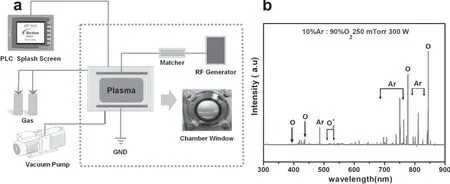
Figure 2.(a) A schematic diagram of the plasma setup,(b) the optical emission spectra from the Ar/O2 discharge.

Table 1.The final aramid sample names.
2.3.Fluorination of the aramid fabric
The aramid fabrics were immersed in aqueous solutions of poly-perfluoralkyl methlacrylate copolymer emulsion,AGE081 (30%,w/w) at room temperature,then padded and dried at 170°C for 2 min.After that,all samples were rinsed with distilled water to eliminate the residual chemicals before tests.The final aramid fabrics are referred to as sample P,sample F and sample PF,according to whether the fabric had been subjected to plasma treatment,the fluorine coating or both,as shown in table 1.The control is referred to as sample C in the following discussion.
2.4.Washing durability test
The washing durability was investigated by subjecting sample F and sample PF to ten washing cycles,which are then referred to as sample FW1,sample FW5,sample FW10and sample PFW1,sample PFW5,sample PFW10,as shown in table 1.Each washing cycle was carried out with standard soap (11 g) for 1 h followed by drying in a microwave at 60°C for 1 h.An AATCC spray test,a hydrocarbon resistance test as well as some other characterization tests were carried out before and after the washing cycles.
2.5.Fabric surface characterization
A field emission scanning electron microscope (FE-SEM,S-4800,Hitachi,Japan) was used to observe the surface morphologies of the aramid fabrics.Before the observation,the samples were coated with a thin gold layer of less than 100 Å to prevent charging on the surface of the fabrics.
ATR-FTIR spectrophotometer attenuated total reflection(Nicolet 6700,Thermo Fisher,USA)was used to analyze the chemical structure of the aramid fabric surface.The FTIR spectra were recorded in the range 500–4000 cm-1at a resolution of 4 cm-1.
The surface chemical compositions of the aramid fabrics were investigated using a Kratos Axis Ultra DLD x-ray photoelectron spectroscope (Shimadzu,Japan)equipped with an Al K source.The base pressure in the analysis chamber was less than 5 × 10–9Torr and the spectra were acquired at a take-off angle of 90°.The binding energy (BE) scale was calibrated according to the C1s peak (284.8 eV) of adventitious carbon on the analyzed fabric surface.Deconvolution analysis of the C1s and O1s peaks was carried out using XPS peak analysis software.
2.6.Water and oil repellency testing
The water contact angles were measured using a drop meter A-200 computer-video-processed goniometer (MALSI,China).The data was read at three different points on each sample,and the averages with standard deviation were calculated.
A homemade right-angle triangle method was employed to test the rolling angles with a 2.9°angle and droplet size of less than 0.03 ml.
For textile fabric in practical application,the resistance of the fabrics to wetting with water was measured by the AATCC spray test method.After the spray test,the wet faces of the different types of aramid fabrics were rated according to the AATCC photographic standards.
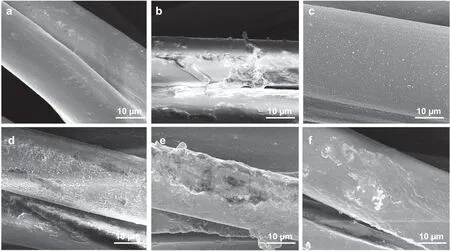
Figure 3.SEM images of aramid fabrics:(a)sample C,(b)sample F,(c)sample FW10,(d)sample P,(e)sample PF,and(f)sample PFW10.
An AATCC hydrocarbon resistance test was carried out to evaluate the resistance of the aramid fabrics to oil stains.A series of four liquid hydrocarbons,including n-tetradecane(grade number 4),n-dodecane (grade number 5),n-decane(grade number 6) and n-oclane (grade number 7) with different surface tensions of 26.4 mN m-1,24.7 mN m-1,23.5 mN m-1and 21.4 mN m-1respectively,were selected for the test.Drops of the standard test liquids were placed on the fabric surface and observed for wetting,wicking and contact angle,with the following results:A=passes with a clear well rounded drop;B=borderline passes with a rounding drop and partial darkening;C=fails with wicking apparent and/or complete wetting and D=fails with complete wetting.The AATCC oil repellency grade is the highest numbered test liquid which does not wet the fabric surface,within a period of 30 ± 2 s.
3.Results and discussions
3.1.Surface morphology
The surface morphology of the aramid fabrics was investigated using SEM,and the images are shown in figure 3.It can be seen from figure 3(a) that the untreated aramid fabric sample C presents a relatively smooth surface.When the untreated fabric was coated directly with AG-E081 emulsion(sample F),only partially covered protrusion shapes appeared in the fabric surface,as shown in figure 3(b),suggesting that some of the fluorine coating had not adhered so closely.Because of the inert chemical properties and smooth surface of the aramid fabrics,the fluorine coating seriously flaked off following ten washing cycles (sample FW10) as seen clearly in figure 3(c).
After plasma treatment,it can be obviously seen that the fabric surface of sample P has become rough and uneven.As presented in figure 3(d),a lot of apparent bulges and ruts can be observed[21].The changes in surface morphology can be attributed to the physical and chemical etching effect caused by active particles in the plasma [22].It is supposed that a rough morphology will be beneficial for the adhesion of the C6 fluorine copolymer [23].After further plasma graft polymerization with the C6 fluorine coating (sample PF),a homogenous layer of C6 fluorine copolymer can be seen,as shown in figure 3(e),indicating that the fiber surface was completely covered with the fluorine copolymer.After ten washes (sample PFW10),the coating was largely preserved and only slight morphology changes were observed as shown in figure 3(f).These results imply that the adhesion of the coating to the fabric was enhanced by plasma pre-treatment.
3.2.Surface chemical structure
ATR-FTIR analysis was used to characterize the chemical structure of the samples,which can confirm the bonding status of the C6 fluorine copolymer onto the aramid fabric.The typical characteristic peaks of the controlled aramid sample are assigned to the C–H/C–N aromatic ring at 853 cm-1,C–O–C stretching at 1083 cm-1and C–H stretching (amide III) at 1240 cm-1;further the C=O stretching in primary amide I at 1643 cm-1and 3292 cm-1is owing to the N–H stretch in the amide terminal (alkynes)[24–26].

Figure 4.The FTIR spectrum of aramid fabrics.(a)Sample C and sample P:storage in air after plasma treatment for 5 h,1 day and 5 days,(b) sample F and sample PF,(c) sample FW10 and sample PFW10.

Table 2.The surface elements of the aramid samples by XPS.
From figure 4(a),the spectrum profiles of the plasmatreated aramid fabrics (sample P,5 h,1 day and 5 days) are not significantly different from the control sample C.However,a difference is noticed for peaks at 1740 cm-1and 1083 cm-1.For sample 5 H(storage in air for 5 h after plasma treatment),a shoulder peak appeared at 1740 cm-1and the intensity at 1740 cm-1increased with the storage time.For samples 1 D and 5 D(storage in air for 1 or 5 days),the peak at 1740 cm-1was obvious.The intensity at 1083 cm-1also increased with the storage time.As will be discussed later in figure 7,this is attributed to the reaction of the active surface with the storage conditions,leading to the introduction of polar groups,such as the COOH group.
In figure 4(b),the intensity of the peak at 1240 cm-1increased significantly for sample PF and sample F compared with sample P.It should be noted that C–F stretching in the aliphatic fluoro-compounds was observed in the range of 1000–1300 cm-1.Thus,this increased peak intensity may indicate that the C6 fluorine copolymer had attached to the fabric surface [27].In addition,there was a new strong absorption peak at 1740 cm-1and its intensity was greater for sample PF than for sample F,which is attributed to the ester groups on the alkyl methlacrylate graft chain [28].This also confirmed the presence of the C–F functional C6 fluorine copolymer on the fabric surface.
As displayed in figure 4(c),after ten washing cycles,the relative intensity of the characteristic peaks of the C6 copolymer at 1740 cm-1and 1240 cm-1decreased,which indicates a decreased amount of the coating after washing.It is also indicates that the relative intensity of the peaks at 1740 cm-1and 1240 cm-1decreased more for sample FW10than for sample PFW10,which shows that the plasma treatment enhanced the tolerance of the C6 copolymer coating to washing.The results indicate that the C6 fluorine functional groups have been introduced into the surface of the aramid fabric after coating,and the plasma treatment facilitated better grafting of the C6 fluorine molecules into the aramid fabric through the introduction of polar groups like COOH.
3.3.Surface chemical composition
The surface chemical compositions of the aramid fabrics were investigated by XPS.Table 2 shows the bond percentages of the surface elements and their relative ratio to carbon.Compared to sample C,the [O]/[C]ratio of sample P increased markedly upon increasing the oxygen concentration.This indicates that new oxygen containing groups had been incorporated into the fabric surfaces,corresponding well with the bond percentage shown in figure 5 and the FTIR results.In comparison with sample C and sample P,the atomic ratio of [F]/[C]of the coated samples (sample F and sample PF)with C6 fluorine increased greatly and this ratio increased most for sample PF.After repeated washing cycles,the[F]/[C]ratio decreased for all the C6 fluorine coated samples.Moreover,the [F]/[C]ratio decreased less for the plasma-treated and coated samples(sample PFW1and sample PFW10)than for only the C6 fluorine coated samples(sample FW1and sample FW10).This result indicates that plasma treatment activated the aramid surface and enhanced the graft polymerization of the active aramid molecules with the C6 fluorine copolymers.
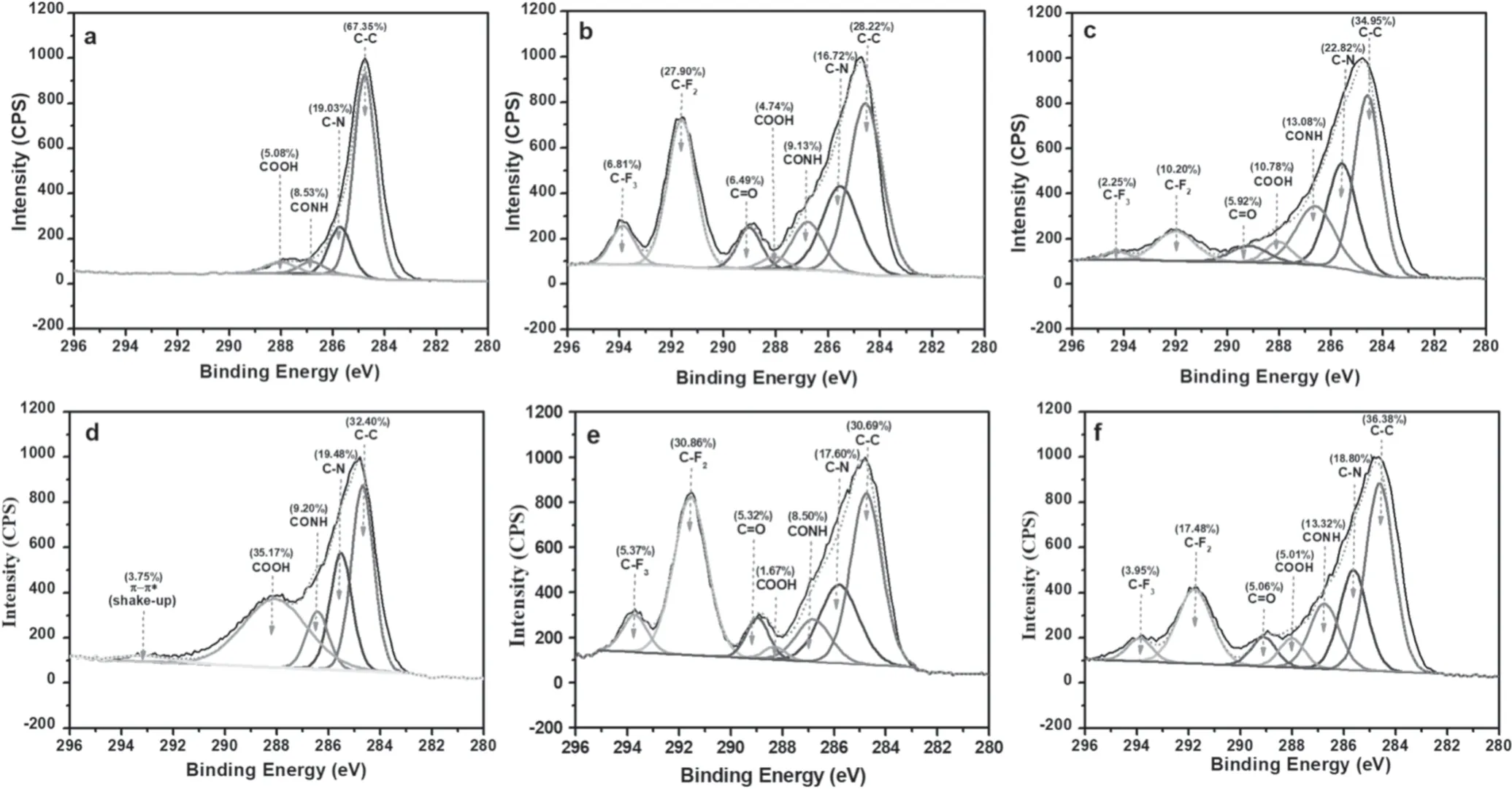
Figure 5.The deconvoluted XPS C1s of the aramid fabrics.(a)Sample C,(b)sample F,(c)sample FW10,(d)sample P,(e)sample PF and(f) sample PFW10.
Deconvolution analysis of the C1s peaks was performed,see figure 5.As shown in figure 5(a)for sample C,there were four kinds of carbon states:C–C at 284.8 eV,C–N/C–O at 285.6 eV,CO–NH at 286.9 eV and CO–OH at 288.5 eV[29].As indicated in figure 5(d) for sample P,the relative intensities of the peaks of CO–OH to C–C increased a lot after plasma treatment due to the broken bonds C–C/C–H and the recombination of oxygen atoms,suggesting that new oxygencontained functional groups C–O,C=O or COOH had been formed [30].Furthermore,the component due to the π–π*shake-up satellite indicated some instauration of the active surface in the plasma polymer [31,32].
After fluorination,three new peaks at 289 eV,291.9 eV and 293.9 eV were observed—see figures 5(b) and (e)—corresponding to C=O,CF2and CF3respectively [33,34].Compared to the directly fluorine-coated sample F in figure 5(b),the relative peak intensity of CF2and CF3in sample PF in figure 5(e) increased significantly,indicating that more fluorine polymer had been introduced into the fabric surface.Moreover,it can also be seen from figure 5(c)that the peak intensities of CF2and CF3are lower after washing for sample FW10than for PFW10.On the basis of this,the washing repellency of the C6 fluorine coating for sample PF is more durable.
3.4.Water and oil repellency performance
It is well known that fluorine functional groups are beneficial to the hydrophobic performance of the surface.The extent of hydrophobic modification of the aramid fabric was studied with a static water contact angle measurement after repeat washing cycles,as shown in figure 6(a).It can be seen that the contact angle value of the direct fluorine coated sample F before washing was 174°.The contact angle declined from 155.1°for one wash to 134°for five washes and 104°for ten(knowing that the sample C contact angle was 99.1°).With a fluorine graft coating,a remarkable increase in contact angle can be seen in figure 6(a).Sample PF exhibited good hydrophobicity with the water contact angle 179.9°.After repeated wash cycles from one,to five and ten,the water contact angles were almost stable at 179.8°,179.7°and 179°,respectively,while the rolling angles were assumed to be less than 2°.Generally,superhydrophobic surfaces exhibit roll-off angles less than 5°,and very specific surfaces can exhibit rolloff angles of less than 1° [35].The rough surface and large amount of reactive radicals that formed on sample PF improved the absorption and reaction of the fluorine molecules on the fabric surface.Further,fluorine molecules graft well compared to sample F,which had a smooth surface with a droopily fluorine coating pointing to a decrease of the contact angle.This means that a durable super hydrophobic surface had formed on the plasma-treated aramid fabrics.

Figure 6.(a) The water contact angle versus washing cycles and (b) water spray standard test (AATCC) photographs after repeat washing cycles from 0,1,5 to 10 respectively on aramid fabrics.(a) Sample F,(b) sample FW1,(c) sample FW5,(d) sample FW10,(e) sample PF,(f) sample PFW1,(f) sample PFW5 and (f) sample PFW10, respectively.
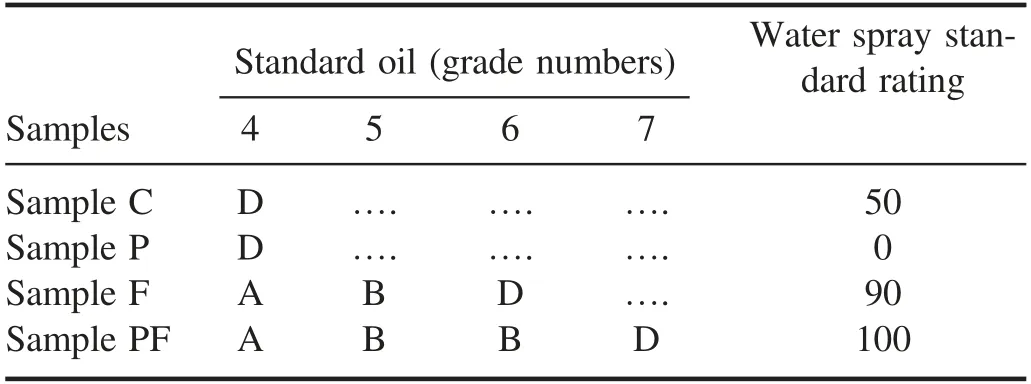
Table 3.Water spray standard test and standard oil test of aramid samples.
To evaluate the water and oil repellent properties in a practical way,a spray test and hydrocarbon resistance test were carried out according to the AATCC standard.As depicted in table 3,sample C showed a spray rating of 50,indicating that the aramid fabric had poor surface hydrophobicity.After plasma treatment,a zero spray rating was obtained for sample P,implying that the fabric is hydrophilic by the plasma modification.Compared with sample C and sample P,sample F and sample PF exhibited a spray rating above 90 after fluorine coating,indicating good water repellency.In addition,sample PF showed a higher spray rating(100) than sample F (90).
For oil repellency,both sample C and sample P showed an oil repellency of D in grade number 4,suggesting that they have poor oil repellency.After fluorine coating,sample F had oil repellency A in grade number 4 and D in grade number 6,indicating good oil repellency gained from the fluorine functional groups.Moreover,sample PF obtained higher oil repellency grades (D in grade number 7) than the other samples,which exhibited the best oil repellency.These results demonstrated that the effectiveness of the introduced fluorine functional groups was enhanced by plasma treatment.
Table 4 summarizes the oil and water repellent durability of the samples after different washing cycles.It can be seen that after one cycle of washing,sample FW1has a B in grade number 4 and C in grade number 5,which shows a decrease compared to sample F.Interestingly,there were no differences in the grades of sample PF W1after washing.After five wash cycles,the oil repellency of sample FW5was not oleophobic in grade number 5.In contrast,sample PFW5remained unchanged in grade numbers 4 and 5,and showed a fail in grade number 6.After ten washing cycles,sample F had no oil repellency,while sample PF still showed an oil repellency of B in grade number 4 and C in grade number 5.
For water repellency durability,the results were consistent with the oil repellency behavior.After one cycle,the spray rating values of sample FW1decreased to 70,while the values remained unchanged for sample PFW1.After five wash cycles,a further decrease of the spray rating values was observed in sample FW5,and only a few changes appeared in sample PFW5.After ten wash cycles,sample FW10showed a disappointing result with a spray rating of 0.Fortunately,the spray rating of sample PF W10remained at 80,which indicates the good durability of the fluorine coating on the aramid fabric achieved by the plasma process.
As shown above,the plasma treatment changed the surface roughness,activated the aramid molecules and introduced oxygen polar groups on the aramid fabric surfaces,by breaking the pi (π),sigma (σ) and delta (δ) bonds at several places on the polymer chains via a free radical initiation.
Figure 7 depicts the fabrication process and the suggested mechanism only breaking the bond at –CO–NH–.The active species of high-energy electrons and ions in plasma can lead to polymer chain scissions,which will create a rough surface and a large amount of reactive radicals.Rough and reactive radicals will react with the circumstance particles and form oxygen-containing functional groups as displayed in FTIR and XPS spectra,becoming reactive and attractive to the thermal dissociated opened C=C bonds in fluorine molecules.This will further improve the absorption and reaction of the fluorine molecules on the fabric surface.Further,fluorine molecules get into the rough surface and then the graft polymerization with opened C=C bonds.Therefore,durable hydrophobic and oleophobic surfaces are obtained.

Table 4.Water spray standard test and standard oil test after repeating washing cycles of aramid samples.
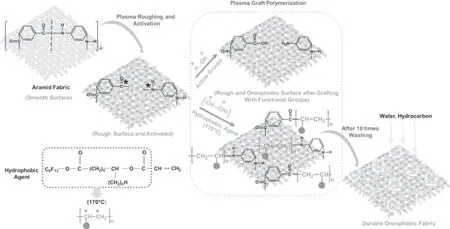
Figure 7.Schematic diagrams for the mechanism of preparing durable omniphobic aramid fabric.
4.Conclusions
In summary,in order to prepare a durable omniphobic aramid surface,the plasma-induced graft polymerization of C6 fluorine copolymer was utilized.Durable superomniphobic surfaces are desirable for practical applications,including self-cleaning,non-fouling,stain-free clothing,drag reduction,corrosion prevention,separation of liquids,for use in protective clothing for firefighters and military applications.After the process,the as-prepared fabrics became super-hydrophobic with a water contact angle of 180°and are kept stable after ten washes.Through the AATCC spray test and hydrocarbon resistance test,the modified fabrics can achieve a B in grade number 6 for oil repellency and a spray rating of 100°(ISO 5)for water repellency.The results of the AATCC spray test and hydrocarbon resistance test also showed good durability after ten washes.The omniphobicity and washing durability can be attributed to abundant active species introduced by the plasma treatment and the effectiveness of the graft C6 fluorine copolymer in the structure of the aramid fabrics,which improved the omniphobicity and washing durability.This study demonstrates that the plasma-induced graft polymerization process is a promising alternative for superomniphobic surface modification with improved washing durability when replacing C8 with C6 fluorine copolymers.
Acknowledgments
This work was supported by the Fundamental Research Funds for the Central Universities 2232019A3-12 and National Natural Science Foundation of China (No.11375042).
猜你喜欢
——辨析聪明、精明、高明、英明
杂志排行
Plasma Science and Technology的其它文章
- Vickers hardness change of the Chinese low-activation ferritic/martensitic steel CLF-1 irradiated with high-energy heavy ions
- Comparison of discharge characteristics and methylene blue degradation through a direct-current excited plasma jet with air and oxygen used as working gases
- Evaluation of influence of cold atmospheric pressure argon plasma operating parameters on degradation of aqueous solution of Reactive Blue 198 (RB-198)
- Plasma-assisted abatement of SF6 in a packed bed plasma reactor:understanding the effect of gas composition
- The far-field plasma characterization in a 600W Hall thruster plume by laser-induced fluorescence
- Experimental study of a low-pressure hybrid RF discharge
